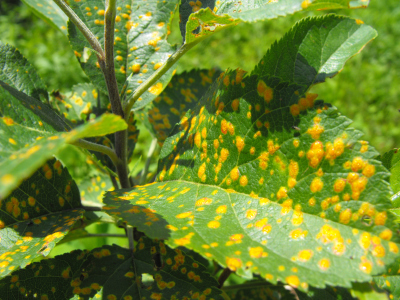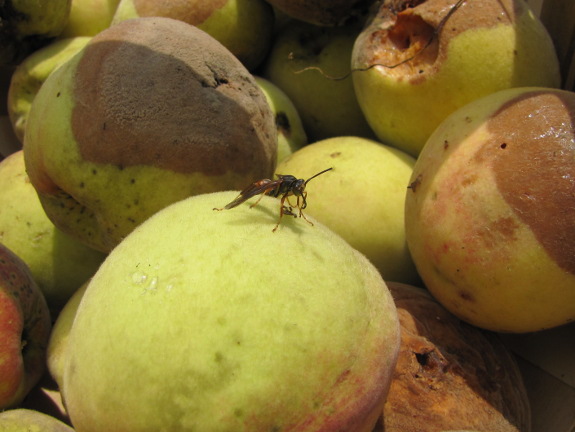
Disease-resistant fruit varieties
 One of my favorite parts of Organic Orcharding
was comparing Logsdon's take on disease-resistant fruit varieties to
the selections chosen by more-modern authors like Lee Reich and Michael
Phillips. In case you're a new reader, you might want to start out
by browsing over these posts:
One of my favorite parts of Organic Orcharding
was comparing Logsdon's take on disease-resistant fruit varieties to
the selections chosen by more-modern authors like Lee Reich and Michael
Phillips. In case you're a new reader, you might want to start out
by browsing over these posts:
What's fascinating when comparing Logsdon's list to those of other
authors is how few varieties appear on both --- apparently trees go out
of style over time, so Reich and Phillips might not have even
experimented with the fruits Logsdon swore by in the 1970s (and vice
versa). For example, although Logsdon's list of pears matches up
with the ones mentioned in the post linked above, most of his resistant
stone fruits aren't on the above lists. Here's  Logdon's selection of stone fruits resistant to brown rot in case you want to give them a shot:
Logdon's selection of stone fruits resistant to brown rot in case you want to give them a shot:
- Alberta, Belle of Georgia, and Redhaven peaches
- Hagan Sweet and Morton nectarine
- Greengage, Ozark Premier, Redheart, and Stanley plums
However, Logsdon does
agree with the other authors that sweet cherries and nectarines are
trouble in humid climates (unless you're willing to grow the cherry
rootstock Mazzard for its small but disease-resistant fruits).
Which brings us to apples. Phillips' extensive (although organic) spray regimen
makes modern readers believe apples are impossible to grow in a
chemical-free fashion, but Logsdon instead considers apples the most
reliable of high-quality fruit species. He makes the argument that
if you choose resistant varieties (see below), use the worst apples for
livestock, the okay ones for cider or cooking, and only expect a third
of your fruits to be dessert quality, you can grow apple trees without
any sprays at all. That sounds like a regiment a homesteader can
get behind!
| Scab |
Fire blight |
Cedar-apple rust |
Powdery mildew |
|
| Adanac |
R |
|||
| Akane |
R |
|||
| Astrachan |
R |
|||
| Baldwin |
R |
|||
| Ben Davis |
R |
|||
| Black Twig |
R |
|||
| Chehalis |
VR |
|||
| Duchess |
S |
R |
||
| Earliblaze |
R |
|||
| Golden Delicious |
R |
S |
S |
R |
| Grimes Golden |
VR |
R |
||
| Jonafree |
VR |
|||
| Jonathan |
R |
S |
S |
|
| Liberty |
I |
VR |
VR |
R |
| MacFree |
I |
|||
| Macoun |
R |
|||
| McIntosh |
S |
R |
S |
|
| Northwest Greening |
R |
|||
| Nova Easy-Grow |
I |
|||
| Prima |
I |
VR |
||
| Priscilla |
I |
VR |
||
| Red Baron |
R |
|||
| Red Delicious |
S |
R |
||
| Sir Prize |
I |
S |
||
| Spartan |
R |
|||
| State Fair |
R |
|||
| Stayman Winesap |
R |
|||
| Transparent |
R |
|||
| Tydeman's Early Red |
R |
|||
| Wagener |
R |
|||
| Winesap |
S |
R |
||
| York Imperial |
VR |
I hope that gives an idea
of where to get started if you want to plant a completely spray-free
orchard. If I run across more lists of resistant varieties in
other books, I'll be sure to update with another post.
| This post is part of our Organic Orcharding lunchtime series.
Read all of the entries: |
Want more in-depth information? Browse through our books.
Or explore more posts by date or by subject.
About us: Anna Hess and Mark Hamilton spent over a decade living self-sufficiently in the mountains of Virginia before moving north to start over from scratch in the foothills of Ohio. They've experimented with permaculture, no-till gardening, trailersteading, home-based microbusinesses and much more, writing about their adventures in both blogs and books.
Want to be notified when new comments are posted on this page? Click on the RSS button after you add a comment to subscribe to the comment feed, or simply check the box beside "email replies to me" while writing your comment.

We have planted a few apple varieties, but still waiting for "fruition". I have also planted a good amount of common apple seedlings I obtained from VA Dept of Forestry to grow as rootstock for future grafts. I understand that good, healthy rootstock is more than half the battle. Once I see what rootstock thrives the most, I will choose which to graft.
I am also a big fan of diversity in species. I have been to a workshop with Alexis Zeigler, who recommends many other fruits not normally seen on store shelves, like persimmons, jujubes, and muscadines. He has a free PDF you can check out: http://conev.org/fruitbook9.pdf
I'm intrigued by the idea of brown rot-free stone fruits. It would be nice. I can say, however, that Belle of Georgia is not one of them. Other guides list it as highly susceptible, and my own experience matches that. I have decent success pulling them a few days before ripening, but the tree is definitely not low-maintenance.
Another interesting apple variety: striped June, aka Margaret. I have cedar apple rust issues with my trees (there are cedars in the woods), but a very old striped June tree seems unfazed. I found an old Auburn University publication noting it was resistant. I wonder if the original homeowner planted it for that reason? It is pretty much a trouble-free tree, but it does get flyspeck and sooty blotch.
Variety 'Apple scab', 'Fire Blight', 'Juniper rusts', 'Powdery Mildew' Liberty VR R VR R Freedom VR VR R R Trent VR MR R R Runkel R R R R novamac VR VR VR VR Rouville R U U U Dayton VR R MR MR Murray R MR R R nova easygrow VR MR S R Priscilla VR R R MR William’s Pride VR R VR R Redfree R MR VR MR Sundance VR R R MR
Forgot where I got this list but there is some here also: http://omafra.gov.on.ca/english/crops/facts/98-013.htm